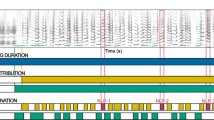Abstract
Behavior emerges from the interaction between the nervous system and peripheral devices. In the case of birdsong production, a delicate and fast control of several muscles is required to control the configuration of the syrinx (the avian vocal organ) and the respiratory system. In particular, the syringealis ventralis muscle is involved in the control of the tension of the vibrating labia and thus affects the frequency modulation of the sound. Nevertheless, the translation of the instructions (which are electrical in nature) into acoustical features is complex and involves nonlinear, dynamical processes. In this work, we present a model of the dynamics of the syringealis ventralis muscle and the labia, which allows calculating the frequency of the generated sound, using as input the electrical activity recorded in the muscle. In addition, the model provides a framework to interpret inter-syllabic activity and hints at the importance of the biomechanical dynamics in determining behavior.







Similar content being viewed by others
References
Alonso R, Goller F, Mindlin GB (2014) Motor control of sound frequency in birdsong involves the interaction between air sac pressure and labial tension. Phys Rev E 89(3):032706
Amador A, Goller F, Mindlin GB (2008) Frequency modulation during song in a suboscine does not require vocal muscles. J Neurophysiol 99(5):2383–2389
Boari S, Perl YS, Amador A, Margoliash D, Mindlin GB (2015) Automatic reconstruction of physiological gestures used in a model of birdsong production. J Neurophysiol 114(5):2912–2922
Boessenecker A, Berry DA, Lohscheller J, Eysholdt U, Doellinger M (2007) Mucosal wave properties of a human vocal fold. Acta Acust United Acust 93(5):815–823
Chiel HJ, Beer RD (1997) The brain has a body: adaptive behavior emerges from interactions of nervous system, body and environment. Trends Neurosci 20(12):553–557
Doellinger M, Berry DA (2006) Visualization and quantification of the medial surface dynamics of an excised human vocal fold during phonation. J Voice 20(3):401–413
Düring DN, Knörlein BJ, Elemans CPH, Schmidt M, Goller F, Riede T, Rome L (2017) In situ vocal fold properties and pitch prediction by dynamic actuation of the songbird syrinx. Sci Rep 7(1):11296
Elemans CPH, Rasmussen JH, Herbst CT, Düring DN, Zollinger SA, Brumm H, Srivastava K, Svane N, Ding M, Larsen ON, Sober SJ, Švec JG (2015) Universal mechanisms of sound production and control in birds and mammals. Nat Commun 6:8978
Goller F, Cooper BG (2004) Peripheral motor dynamics of song production in the zebra finch. Ann NY Acad Sci 1016(1):130–152
Goller F, Riede T (2013) Integrative physiology of fundamental frequency control in birds. J Physiol Paris 107(3):230–242
Goller F, Suthers RA (1996a) Role of syringeal muscles in controlling the phonology of bird song. J Neurophysiol 76(1):287–300
Goller F, Suthers RA (1996b) Role of syringeal muscles in gating airflow and sound production in singing brown thrashers. J Neurophysiol 75(2):867–876
Jensen KK, Cooper BG, Larsen ON, Goller F (2007) Songbirds use pulse tone register in two voices to generate low-frequency sound. Proc R Soc Lond B Biol Sci 274(1626):2703–2710
Laje R, Gardner TJ, Mindlin GB (2002) Neuromuscular control of vocalizations in birdsong: A model. Phys Rev E 65(5):051921
Mencio C, Kuberan B, Goller F (2017) Contributions of rapid neuromuscular transmission to the fine control of acoustic parameters of birdsong. J Neurophysiol 117(2):637–645
Riede T, Fisher JH, Goller F (2010) Sexual dimorphism of the zebra finch syrinx indicates adaptation for high fundamental frequencies in males. PLoS One 5(6):e11368
Rokni U, Sompolinsky H (2012) How the brain generates movement. Neural Comput 24(2):289–331
Shapiro MB, Kenyon RV (2000) Control variables in mechanical muscle models: A mini-review and a new model. Motor Control 4(3):329–349
Srivastava KH, Elemans CP, Sober SJ (2015) Multifunctional and context-dependent control of vocal acoustics by individual muscles. J Neurosci 35(42):14183–14194
Vicario DS (1991) Contributions of syringeal muscles to respiration and vocalization in the zebra finch. J Neurobiol 22(1):63–73
Author information
Authors and Affiliations
Corresponding author
Ethics declarations
Conflict of interest
The authors declare that they have no conflict of interest.
Funding
This work describes research partially funded by National Council of Scientific and Technical Research (CONICET), National Agency of Science and Technology (ANPCyT), University of Buenos Aires (UBA) and National Institute of Health through R01-DC-012859.
Ethical approval
All applicable international, national, and/or institutional guidelines for the care and use of animals were followed.
Rights and permissions
About this article
Cite this article
Döppler, J.F., Bush, A., Goller, F. et al. From electromyographic activity to frequency modulation in zebra finch song. J Comp Physiol A 204, 209–217 (2018). https://doi.org/10.1007/s00359-017-1231-3
Received:
Revised:
Accepted:
Published:
Issue Date:
DOI: https://doi.org/10.1007/s00359-017-1231-3




